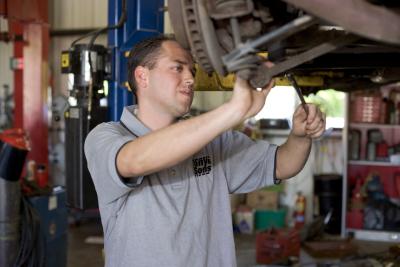
Car owners should pay attention to the telltale signs of when a wheel alignment is needed. An alignment normally is needed when the parts that hold the wheels in place begin to show wear, meaning the wheels are no longer completely parallel with each other or flat to the road surface. According to Kudzu.com, keeping your car properly aligned saves gas and makes your car easier to control.
Improper alignment can show up in a variety of ways, but one of the more visible ways is in how your tires are wearing. If your tires are wearing unevenly, with the outsides getting worn down to below the tread while there is still tread in the middle, you are in need of an alignment. If the tires on one side of your vehicle seem to wear faster than those on the other side, you need to get your vehicle's alignment checked. It only takes a few seconds to look your car tires over, but those few seconds could spur you to have necessary maintenance done.
Whenever you get new tires you should have your vehicle's alignment checked. As was mentioned previously, one of the main results of a badly aligned vehicle is uneven and accelerated wear on the tires. In order to make sure you get the most out of your new tires, make certain that your vehicle's alignment is perfect and any worn parts are replaced immediately. New tires also should allow you better control of your vehicle, but when your alignment is off you lose that extra control. Get the full benefit of your new tires with a proper alignment.
If you constantly need to turn your wheel slightly just to keep your vehicle driving straight, then you may need an alignment. You can check this when you are on an open road with no other vehicles around; get your vehicle up to no more than 30 miles per hour and briefly let go of the steering wheel. If the vehicle pulls instantly to one side, you need an alignment. Do not grab the wheel suddenly and try to pull the vehicle back. Calmly place your hands on the wheel and gradually move the vehicle back to the center of the road, or just stop the vehicle.